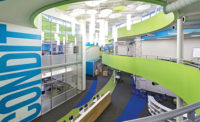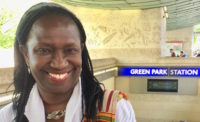Converting a disused rainwater collection tank into a children’s library could not, under any circumstances, be called an obvious design solution. But that’s exactly what one nonprofit asked San Francisco–based Natoma Architects to do, in a small farming community in the Nyeri West region of Kenya, a four-hour drive north of Nairobi.
The Nobelity Project, an Austin, Texas–based group that builds critically needed school infrastructure, is known for looking beyond easy answers to meet a community’s needs. While undertaking the Nyeri West school renovation some years back, the organization’s cofounder, Turk Pipkin, saw the nearby cistern and, noting its unusually large size, saw the potential of its robust, curved form for housing books. The 70-year-old tank had a diameter of 25 feet inside its thick, plastered brick walls, which rose 9 feet high. It was conveniently situated behind the property’s cattle sheds-turned-classrooms. It even had a prominent site on a hillside—with views out to Mount Kenya—and could be seen from the road leading up to the school. And, for locals, who were given the tank (and the rest of the formerly British-owned dairy farm on which it sits) when Kenya declared its independence from the United Kingdom in 1963, it also had sentimental value.
Pipkin was convinced that recreating this agricultural artifact for adaptation as a library would be an encouraging reminder of how far the community had come—if he could find an architect capable of making it work. A friend in whom Pipkin had confided had studied architecture with someone who could help. He introduced Pipkin to Natoma principal Stanley Saitowitz, who was born in South Africa, knew the continent’s colonial history, and was struck by the potent symbolism of preserving the existing structure. “I grew up in Johannesburg,” says the architect. “I understand that water has always been a precious resource in Africa.”
The square-on-circle form the architect designed is a nod to Africa’s colonial legacy: it merges the rectilinear geometry common to Europe with the rounded forms of traditional African architecture. His choice of building materials underscores the formal combination: corrugated-steel sheeting (a British import) clads the square part of the building, complementing the original indigenous brick structure below. “Growing up in South Africa, I was able to see how, when you go into the countryside, this other architectural language will emerge,” Saitowitz says, referring to the familiar sight of buildings composed of both imported and local components. Insisting that the new library should still collect water, the architect topped it with a roof that has an inverted pitch, which feeds a small receptacle behind the structure.
“The entire design essentially arose from dealing with the constraints of the tank,” says Saitowitz, who was determined to leave the cistern untouched. As if out of deference to the relic, he avoided cutting through the circular wall to create an entry and, instead, designed a stair leading into the square volume above. “It is an elevating experience to go up to the books and then down a stair to the main gathering space back at grade,” he says. On the top level, a wraparound corrugated-steel landing is lined with bookshelves that are built into its perimeter walls. To admit daylight and breezes, Saitowitz used louvered glass behind wire mesh at the room’s corners.
From this mezzanine, a steel stair spirals down to the circular room below—the heart of the library, which has a new concrete slab, covered in tile. Here, the steel bookshelves define the space, creating small reading nooks at the edges, while at the same time, supporting the load of the new volume above. Saitowitz’s only intervention with the historic walls, beyond applying a fresh coat of plaster, was to install half-moon slivers of bent steel on its surfaces to create child-height reading seats in the nooks. “The kids use them more as desks,” he says.
The diminutive library’s scrappy elegance is well suited to the spirit of the people who use it. When Nobelity embarked on building the property’s new preschool, parents eagerly volunteered to dig the foundation trenches. Later, when a truck loaded with donated books bound for the library became mired in mud just yards from the door, young students resolutely carried the large boxes the rest of the way. “For this community,” says Pipkin, “the library says that good things can happen here.”











Post a comment to this article
Report Abusive Comment